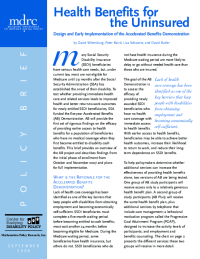Health Benefits for the Uninsured
Design and Early Implementation of the Accelerated Benefits Demonstration
Many Social Security Disability Insurance (SSDI) beneficiaries have serious health care needs, but, under current law, most are not eligible for Medicare until 29 months after the Social Security Administration (SSA) has established the onset of their disability. To test whether providing immediate health care and related services leads to improved health and better return-to-work outcomes for newly entitled SSDI beneficiaries, SSA funded the five-year Accelerated Benefits (AB) Demonstration. AB will provide the first set of rigorous findings on the efficacy of providing earlier access to health benefits for a population of beneficiaries who have no medical coverage when they first become entitled to disability cash benefits. This policy brief provides an overview of the AB project and describes findings from the initial phase of enrollment from October and November 2007 and plans for full implementation.
What Is the Rationale for the Accelerated Benefits Demonstration?
Lack of health care coverage has been identified as one of the key barriers that keep people with disabilities from obtaining employment and becoming economically self-sufficient. SSDI beneficiaries must complete a five-month waiting period before becoming entitled to cash benefits; most wait another 24 months before becoming eligible for Medicare. During the Medicare waiting period, some beneficiaries have health insurance, but others do not. SSDI beneficiaries who do not have health insurance during the Medicare waiting period are more likely to delay or go without needed health care than those who are insured.
The goal of the AB Demonstration is to assess the efficacy of providing newly awarded SSDI beneficiaries who have no health care coverage with immediate access to health benefits. With earlier access to health benefits, beneficiaries may be able to achieve better health outcomes, increase their likelihood to return to work, and reduce their long-term dependence on SSDI benefits.
To help policymakers determine whether additional services can increase the effectiveness of providing health benefits alone, two versions of AB are being tested. One group of AB study participants will receive access only to a relatively generous health benefit plan. A second group of study participants (AB Plus) will receive the same health benefit plan, plus additional services by telephone that include care management; a behavioral motivation program called the Progressive Goal Attainment Program (PGAP), designed to increase the activity levels of participants; and employment and benefits counseling.
The rigorous evaluation of AB will provide SSA with empirical data with which to analyze the role that early access to health care benefits plays in health and employment outcomes for SSDI beneficiaries. The evaluation will also inform policymakers about the potential for improving health care coverage, including legislation aimed at eliminating the Medicare waiting period, such as The Ending the Medicare Disability Waiting Period Act of 2007. These findings will also complement SSA’s other demonstration projects, which policymakers can use to identify the best combination of supports in serving SSDI beneficiaries.
What’s Next?
Based on the successful recruitment and enrollment findings during the initial phase, which are described in the policy brief, the full rollout of the demonstration started in March 2008 and includes enrollment activities for the remaining 1,934 participants in 53 large metropolitan areas.
The research team will document findings in three reports throughout the implementation of the AB demonstration until the completion of the project in January 2011:
- The Project Monitoring Report (expected February 2009) will provide information on how AB and AB Plus services were used during the first six months of the demonstration and will describe any differences in health benefits usage by AB and AB Plus treatment groups.
- The Interim Report (expected October 2009) will describe the enrollment process and the characteristics of the target population. This report will document how the interventions are being delivered by drawing on quantitative and qualitative data.
- The Final Report (expected January 2011) will contain a full evaluation of all activities, including a summary of the implementation, impact, and cost-benefit findings.






